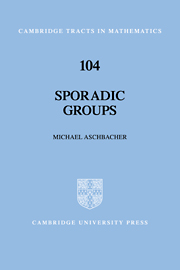3 - Algebras, Codes, and Forms
Published online by Cambridge University Press: 04 August 2010
Summary
The Griess Algebra is a certain nonassociative, commutative algebra on 196,884 dimensional Euclidean space constructed by R. Griess. Its automorphism group is the largest sporadic group, the Monster. In Section 9 we record a few elementary facts about algebras; in particular we find that a nondegenerate bilinear form γ on a space V determines an isomorphism between the space of algebras on V and the space of trilinear forms on V. Thus the Griess algebra corresponds to a trilinear form and in Chapter 10 we use both the algebra and the form to construct the Monster.
In Section 11 we find that each map P : V → F of a vector space V over the field F of order 2 into F with P(0) = 0 determines a sequence of derived forms Pm : Vm → F. This sequence is used in Chapter 4 to study a certain class of loops we call symplectic 2-loops which are generalizations of 2-groups of symplectic type. Following Conway, we use a certain symplectic 2-loop discovered by Parker to construct a 2-local in the Monster and then in Chapter 10 use this 2-local to assist in the construction of the Griess algebra.
In Section 10 we briefly recall a few elementary facts about error correcting codes. In Chapter 6 the Steiner system for the Mathieu group M24 is used to construct the Golay code, a doubly even binary code preserved by M24. In Section 11 we find that each binary code V naturally determines a map P and its derived sequence. If the code is doubly even then P3 is a trilinear form.
- Type
- Chapter
- Information
- Sporadic Groups , pp. 35 - 45Publisher: Cambridge University PressPrint publication year: 1994

